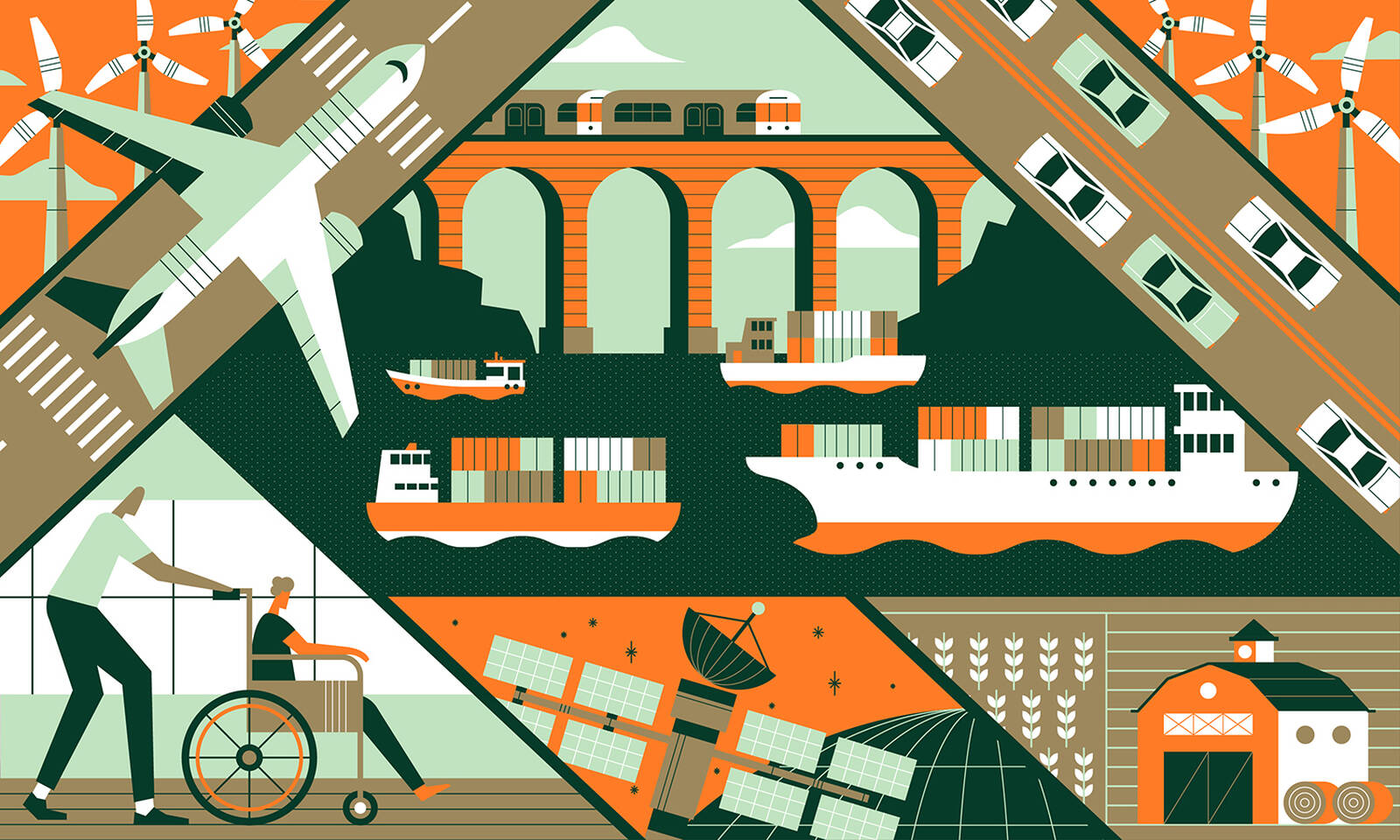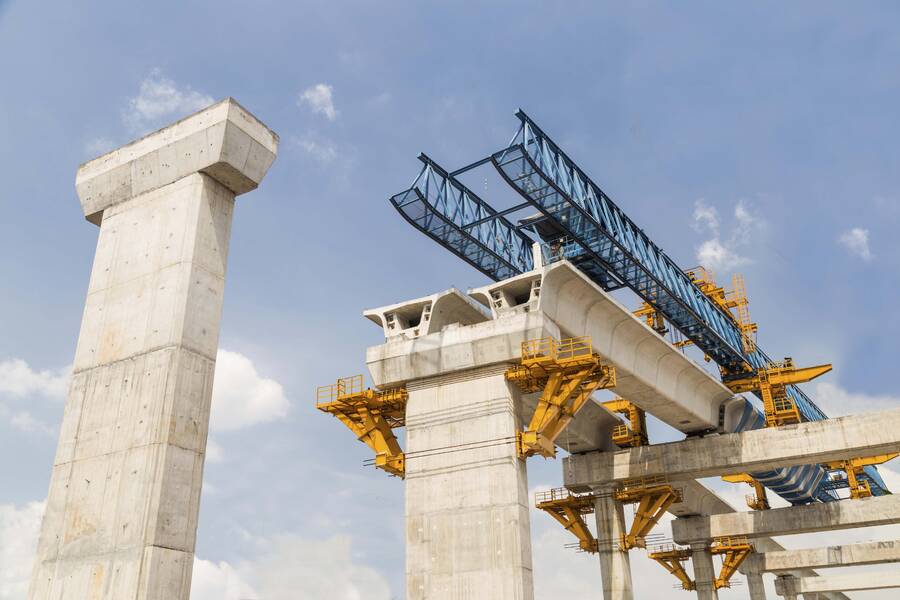Policy May 4, 2021
Why Spending Big on U.S. Infrastructure Makes Sense
A Kellogg professor explains the new appetite for large public investment—and how the American Jobs Act would deliver.

In early April, President Biden announced a $2 trillion infrastructure plan, which goes beyond the traditional outlays for roads and bridges to encompass public transit, the electric grid, jobs training, research, housing, broadband, water systems, and investments in healthcare and childcare.
“This bill certainly widens the scope of what we traditionally think of as infrastructure,” says David Besanko, the IBM Professor of Regulation and Competitive Practices at the Kellogg School, whose research focuses on infrastructure. “But given all of the challenges we’ve faced over the past year, I think there’s a greater appetite now for large public investment.”
The pandemic has certainly played a role in creating such an appetite. But so have recent high-profile failures of U.S. infrastructure, including major outages across the Texas power grid, the collapse of dams in Michigan, the stalling of high-speed rail in California, and the spillage at a wastewater reservoir in Florida.
“All of these events drive home the importance of infrastructure,” Besanko says. “We’ve also seen, on the positive side, that our ports and railway systems are remarkably efficient. But there’s so much else we can’t see that’s just as critical.”
Of course, Biden’s infrastructure plan is not yet law, and its scope might yet be constrained through negotiations. But the plan does go a long way toward revealing the new administration’s priorities.
Besanko explains the critical elements of the new plan—including what has been left out—and why he believes there may be an appetite for the administration’s decision to go big.
A Broad View of Infrastructure
Biden’s bill lays out three categories of investment. The first category includes public-works projects like roads, bridges, airports, seaports, and water systems. The second is focused primarily on low-carbon energy, including the infrastructure needed for a shift to electric vehicles. The third, “social infrastructure,” includes investment in schools, hospitals, community colleges, and federal buildings.
In Besanko’s view, this kind of broad investment is justified, even if some of the projects might not quite be what the American public has in mind when they think of the word infrastructure.
Take, for example, the computer systems for critical federal programs, such as those that processed unemployment claims throughout the pandemic. In many cases, the flurry of claims overwhelmed the processing power of an aging digital architecture.
“We don’t ordinarily think of this as infrastructure, but it really is, if you define infrastructure as the systems and processes that underlie the workings of a modern economy. In fact, a lot of the best investments are going to be invisible.”
Another “invisible” initiative is retrofitting school buildings to make them more energy efficient. Many public schools lack proper heating and air-conditioning systems, which ultimately limits their operational capacity. In addition to increasing energy efficiency, investing in heating and air-conditioning would enable some schools to remain open for a longer school year, helping to address the learning gaps that have widened throughout the previous year of online teaching.
“I think we’re going to see the more traditional public model, where we simply put money into the pockets of state and local governments and have them spend the money on the projects that they need.”
— David Besanko
“It’s boring, it’s not photogenic at all, but it’s probably one of the best infrastructure investments that we could make, in terms of the positive social return,” Besanko says.
But there is plenty of ambition around more “visible” projects as well—particularly when it comes to refurbishing existing assets. For instance, Biden’s plan proposes to modernize 20,000 miles of highways and roads, and repair 10,000 bridges.
To Besanko, this move to shore up the nation’s physical infrastructure is long overdue. Proper maintenance of highways and bridges, for example, can help reduce congestion, limit damage to cars and trucks, and increase overall safety. “The social rate of return on maintaining a highway—if you do it efficiently—is going to be a lot higher than a new road or bridge,” he says.
Other major refurbishing projects might be necessary to fix critical damage from natural disasters. The Hudson River tunnels between New York City and New Jersey, another essential artery for both commercial and commuter traffic, were badly damaged during Hurricane Sandy and are still in need of repair.
“It is encouraging that the Biden administration has approved moving forward on the Hudson Tunnel project, which had been stalled by the Trump administration,” Besanko says. “It is a critical piece of the Gateway Program initiative to upgrade the rail link between Newark, New Jersey, and New York City, which is one of the most heavily traveled stretches of track in the country.”
A Reduced Role for Public–Private Partnerships
Make no mistake: the Biden administration’s infrastructure plan is comprehensive and ambitious. But one thing Besanko does not see in the plan is a major role for public–private partnership initiatives.
“I think we’re going to see the more traditional public model,” he says, “where we simply put money into the pockets of state and local governments and have them spend the money on the projects that they need.”
This is a departure from the approach taken by the previous administration. Despite his campaign promises, President Trump did little to ramp up federal spending on infrastructure projects. But to the extent that there was federal spending, it tended towards public–private partnership initiatives, perhaps due to a sense that the American public was skeptical of large, costly projects that required considerable federal spending.
But Besanko thinks we have entered a new climate where skepticism for government spending is balanced by an appreciation for its possible long-term benefits.
“We’ve seen that government can play a constructive role in a crisis. The Cares Act put a lot of money directly into people’s pockets, which drove spending and kept others from falling into poverty,” Besanko says. “I think the public is more willing to accept a $2 trillion investment in federal initiatives, which was inconceivable only ten years ago. The Obama administration felt that they couldn’t even propose a plan that exceeded $1 trillion, though as we know now, a far larger stimulus would have helped.”
Relying on public, rather than private, spending opens the door to a far wider range of projects, in terms of protecting the valuable infrastructure we already have while also expanding federal services to underserved areas. That’s because, for all the interest they generate, public–private partnerships are quite limited by their complexity and by the challenge of establishing user-fee structures.
There are some notable exceptions. One high-profile rehabilitation project that Besanko thinks would be well suited to public–private funding is the Brent Spence Bridge, which crosses the Ohio River and serves as a key artery of highway traffic on I-75.
“This is one of the most traversed bridges in the country,” Besanko says. “It was built in 1963 and remains dangerously undermaintained. So here’s a case where you might need to build a new bridge.”
The project has a nearby precedent in the Lewis and Clark Bridge, a toll bridge spanning the Ohio River near Louisville, which opened in 2016.
But while public–private partnerships might be useful for, say, spurring new investments in one-off bridge constructions or freight rail, privatization is far less useful for expanding broadband access, which is one of Biden’s priorities. Relying on the private sector alone would likely only ensure that broadband service improves in major cities, since that is where most private companies can earn back their investment; it may not do much to ensure that people in rural areas can get online.
“This is exactly the kind of project that needs federal funding, and I hope it goes forward. It will confirm our belief that government has a role to play in our lives.”
Andrew Warren is a writer based in Los Angeles.



